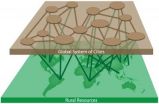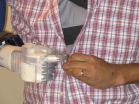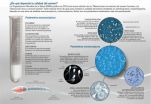(Press-News.org) City leaders aspiring to transform their cities into models of sustainability must look beyond city limits and include in their calculation the global flow of goods and materials into their realm, argue researchers in the Royal Swedish Academy of Sciences journal Ambio.
Many cities are now developing sustainable strategies to reduce pollution and congestion, improve the quality of life of their citizens, and respond to growing concern about human impact on climate and the environment. But sustainable city initiatives often ignore the environmental footprint from imported goods and services such as food, water, and energy to cities: sustainability, it seems, stops at the city limits.
Ultimately, this will not add up to a planet able to support over nine billion people.
"The sustainability of a city can no longer be thought of in isolation from the combined resource use and impacts of cities globally." Urbanization is no longer a local issue, say Earth-system researchers in a new paper, Planetary stewardship in an urbanizing world: beyond city limits, published October 2012.
Instead, the team proposes that cities analyse how resources consumed within a city are sourced, produced and transported. They suggest one solution could be that cities with viable sustainability strategies link together to create a vast system of cities. A feature of such a system would be an awareness of the global resource use of cities combined. The benefits of a network of this kind could be twofold, contributing to "planetary stewardship" whilst providing long-term resource security for cities.
"Urban areas drive much of the global changes we see, whether in energy use, food supply, resource depletion or land-use change," says lead author Dr. Sybil Seitzinger, Executive Director of the International Geosphere-Biosphere Programme, based in Stockholm Sweden.
The world has urbanized rapidly. In 2011, the United Nations announced humanity had passed a major landmark: over half the population of the planet now lives in urban areas. Urbanization is set to continue at pace throughout this century with most growth taking place in Africa and Asia.
The total urban area is expected to triple between 2000 and 2030, while urban populations are expected to nearly double, increasing from 2.84 to 4.9 billion, during this period, according to a recent publication in the Proceedings of the National Academy of Sciences of the United States of America.
"On this kind of trajectory, more than 15,000 football fields (FIFA accredited) will become urban every day during the first three decades of the 21st century. In other words, humankind is expected to build more urban areas during the first thirty years of this century than all of history combined,," says Professor Karen Seto an urbanization expert from Yale University and co-author on the paper.
A system of sustainable cities will require adequate information on resource flows and their impacts, preferably in near-real-time and on a global scale. "Digital technologies are now putting this kind of information within our grasp," says Dr. Seitzinger.
Recently, cities across the globe have joined forces in alliances to curb greenhouse gas emissions, for example through the C40 Cities Climate Leadership Group and the World Mayor's Council for Climate Change. This approach allows cities to learn from one another. Good ideas can spread through the network while poor ideas can be ditched quickly.
However, these efforts may not focus explicitly on non-urban regions that often provide resources to urban areas. The notion of a partnership between "sustainable" cities and between cities and non-urban regions discussed in the paper is novel but untested. The new approach could harness existing partnerships and provide the foundations for a more sustainable approach to urbanization and urban living this century.
The new research is the outcome of a three-day international workshop on planetary stewardship organised by the International Geosphere-Biosphere Programme at the Royal Swedish Academy of Sciences, 13-15 June 2011.
INFORMATION:
http://www.igbp.net/5.1b8ae20512db692f2a6800013506.html
NOTES
The paper, Planetary stewardship in an urbanising world: beyond city limits, is open access.
http://www.springerlink.com/content/t06251122wp126p3/fulltext.pdf
http://www.springerlink.com/content/1654-7209
For a copy of the paper and interview requests contact
Owen Gaffney
Owen.gaffney@igbp.kva.se
Director of communications, International Geosphere-Biosphere Programme, Royal Swedish Academy of Sciences, Stockholm, Sweden
Tel:+46 86739556
Mob:+46 730208418
Planetary stewardship in an urbanising world: beyond city limits. AMBIO DOI : 10.1007/s13280-012-0353-7. Seitzinger, S.P., U. Svedin, C. Crumley, W. Steffen, S. A. Abdullah, C. Alfsen, W. J. Broadgate, F. H.B. Biermann, N. R. Bondre, J. A. Dearing, L. Deutsch, S. Dhakal, T. Elmqvist, N. Farahbakhshazad, O. Gaffney, H. Haberl, S. Lavorel, C. Mbow, A. J. McMichael, J. Morais, P. Olsson, P. Pinho, K. C. Seto, P. Sinclair, M. Stafford-Smith, L. Sugar. 2012.
http://www.springerlink.com/content/t06251122wp126p3/fulltext.pdf
http://www.springerlink.com/content/1654-7209
See also:
Global forecasts of urban expansion to 2030 and direct impacts on biodiversity and carbon pools
http://www.pnas.org/content/early/2012/09/11/1211658109
Sustainable cities must look beyond city limits
Planetary stewardship in an urbanising world: Beyond city limits
2012-10-31
ELSE PRESS RELEASES FROM THIS DATE:
New metric to track prosthetic arm progress
2012-10-31
PROVIDENCE, R.I. [Brown University] — Amputees with a new prosthetic arm must learn how to use their device to perform everyday tasks that were once second nature. Taking off a shirt becomes a conscious, multistep effort: grasp the shirt, lift the shirt over the head, pull arms through the sleeves, place the shirt on the table, let go of the shirt.
In the best cases of treatment, patients work with teams of doctors, prosthetists, and therapists to learn how their new limbs can help them regain function and quality of life. But clinicians have had few tools to assess ...
New hope for survivors of stroke and traumatic brain injury
2012-10-31
A new ground-breaking study about to be published in the Adis journal CNS Drugs provides clinical evidence that, for the first time, chronic neurological dysfunction from stroke or traumatic brain injury can rapidly improve following a single dose of a drug that targets brain inflammation, even years after the stroke or traumatic event.
The observational study¹ of 629 patients, conducted over the course of nearly two years, documents a diverse range of positive effects, including statistically significant rapid clinical improvement in motor impairment, spasticity, cognition, ...
Graphene mini-lab
2012-10-31
A team of physicists from Europe and South Africa showed that electrons moving randomly in graphene can mimic the dynamics of particles such as cosmic rays, despite travelling at a fraction of their speed, in a paper about to be published in EPJ B.
Andrey Pototsky and colleagues made use of their knowledge of graphene, which is made of a carbon layer, one atom thick, and packed in a honeycomb lattice pattern. In such material the interaction of electrons with atoms changes the effective mass of the electrons. As a result, the energy of electrons in graphene becomes similar ...
First-ever 3-D stress map of developing embryonic heart sheds light on why defects form
2012-10-31
WASHINGTON, Oct. 31—As a human fetus develops, its heart has to keep pace with the new body's ever-growing demands. Much of this is controlled by following genetic blueprints, but the embryonic heart also matures in response to the intense stresses of pumping blood. For the first time, researchers have been able to visualize in 3-D the stresses induced by flowing blood in an embryonic heart. The technique, which promises to provide new insight into how and why heart defects develop, is described in a paper published today in the Optical Society's (OSA) open-access journal ...
Unlocking the secrets of DNA repair
2012-10-31
Scientists from the University of Sheffield have unlocked one of the secrets to DNA repair –helping doctors identify DNA base damage and a patient's susceptibility to certain types of cancer.
Groundbreaking research led by Dr David Williams from the University of Sheffield's Department of Chemistry and an international collaboration of expert researchers has discovered how some proteins recognise damaged bases within DNA which, if untreated, could lead to cancer.
Dr Williams said: "Proteins carry out all the day-to-day processes needed for survival. If the DNA bases ...
How and why herpes viruses reactivate to cause disease
2012-10-31
The mere mention of the word "herpes" usually conjures negative images and stereotypes, but most people have been infected with some form of the virus. For most, a sore appears, heals and is forgotten, although the virus remains latent just waiting for the right circumstances to come back. Now, the mystery behind what triggers the virus to become active again is closer to being solved thanks to new research published in the Journal of Leukocyte Biology's November 2012 issue. In the report, scientists show how the immune system may lose its control over the virus when facing ...
Men who do exercise produce better quality semen
2012-10-31
A new study conducted by researchers at the University of Cordoba links moderate physical activity in males with better hormone levels and sperm characteristics that favour reproduction compared to sedentary men.
Semen quality at large has dropped in the last 50 years. Amongst other factors, this is due to exposure to external agents and alcohol and tobacco consumption. This decline in sperm properties has caused an increase in reproductive problems.
Therefore, experts have studied the possible relationship between sperm quality and lifestyle habits in males. Published ...
Microscopic packets of stem cell factors could be key to preventing lung disease in babies
2012-10-31
Boston, Mass.—Researchers at Boston Children's Hospital have found that microscopic particles containing proteins and nucleic acids called exosomes could potentially protect the fragile lungs of premature babies from serious lung diseases and chronic lung injury caused by inflammation.
The findings explain earlier research suggesting that while transplanting a kind of stem cell called mesenchymal stem cells (MSCs) could help reduce lung injury and prevent inflammation in a mouse model, the fluid in which the cells were grown was more effective than the cells themselves.
The ...
Biofuel breakthrough: Quick cook method turns algae into oil
2012-10-31
ANN ARBOR—It looks like Mother Nature was wasting her time with a multimillion-year process to produce crude oil. Michigan Engineering researchers can "pressure-cook" algae for as little as a minute and transform an unprecedented 65 percent of the green slime into biocrude.
"We're trying to mimic the process in nature that forms crude oil with marine organisms," said Phil Savage, an Arthur F. Thurnau professor and a professor of chemical engineering at the University of Michigan.
The findings will be presented Nov. 1 at the 2012 American Institute of Chemical Engineers ...
Scientists unravel resistance to breast cancer treatment
2012-10-31
Scientists have identified a molecular 'flag' in women with breast cancer who do not respond or have become resistant to the hormone drug tamoxifen.
Tamoxifen – used alongside traditional chemotherapy and radiotherapy – blocks the female hormone oestrogen that, in certain breast cancers, is required by the tumour to grow; it has been shown to improve cancer survival rates by up to one third.
However, about one third of patients with the appropriate type of breast cancer – known as oestrogen receptor positive breast cancer – do not respond to tamoxifen or develop resistance ...
LAST 30 PRESS RELEASES:
Electrodes created using light
Second-hand gift-giving is a well-deliberated decision
How human interaction drove evolution to make bears less aggressive
National Poll: Few parents offer teens guidance on healthy eating during holiday season
Cannabis derivatives could provide new ovarian cancer treatments
Raising strong yeast as a petroleum substitute
Clues to the origin of hot Jupiters hidden in their orbits
Canada’s reduced pledge to Global Fund will impact domestic health
1 in 4 children with major traumatic injuries not cared for in pediatric trauma centres
Duke and Duke-NUS’ joint cross-population research to uncover "East-West" differences in disease and care
Scientists to ‘spy’ on cancer- immune cell interactions using quantum technology breakthrough
Tech savvy users have most digital concerns
Making lighter work of calculating fluid and heat flow
Normalizing blood sugar can halve heart attack risk
Lowering blood sugar cuts heart attack risk in people with prediabetes
Study links genetic variants to risk of blinding eye disease in premature infants
Non-opioid ‘pain sponge’ therapy halts cartilage degeneration and relieves chronic pain
AI can pick up cultural values by mimicking how kids learn
China’s ecological redlines offer fast track to 30 x 30 global conservation goal
Invisible indoor threats: emerging household contaminants and their growing risks to human health
Adding antibody treatment to chemo boosts outcomes for children with rare cancer
Germline pathogenic variants among women without a history of breast cancer
Tanning beds triple melanoma risk, potentially causing broad DNA damage
Unique bond identified as key to viral infection speed
Indoor tanning makes youthful skin much older on a genetic level
Mouse model sheds new light on the causes and potential solutions to human GI problems linked to muscular dystrophy
The Journal of Nuclear Medicine ahead-of-print tip sheet: December 12, 2025
Smarter tools for peering into the microscopic world
Applications open for funding to conduct research in the Kinsey Institute archives
Global measure underestimates the severity of food insecurity
[Press-News.org] Sustainable cities must look beyond city limitsPlanetary stewardship in an urbanising world: Beyond city limits



